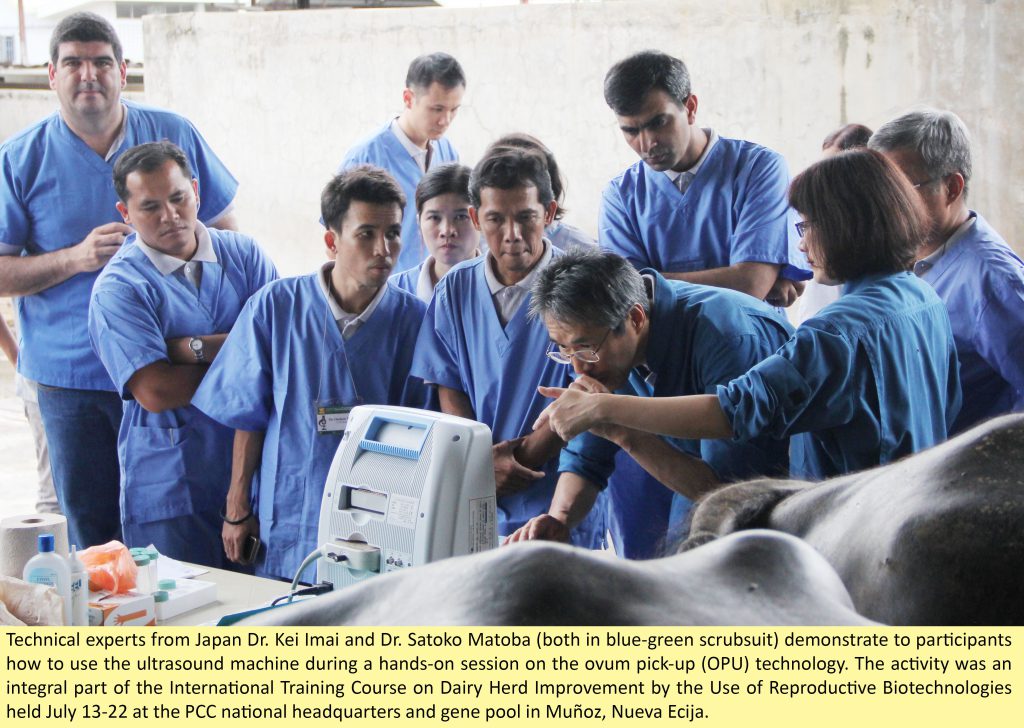Reproductive technologies are helpful tools in improving and multiplying the dairy herd.
This was stressed by Dr. Eufrocina Atabay, head of the Reproductive Biotechnology and Physiology Unit of the Philippine Carabao Center (PCC), as 17 participants from 10 countries completed an “International Training Course on Dairy Herd Improvement by the Use of Reproductive Biotechnology” held at PCC on July 13-22.
The training course was organized by the PCC in collaboration with the Philippine Council for Agriculture, Aquatic and Natural Resources Research Development (PCAARRD) of the Department of Science and Technology (DOST) and Food and Fertilizer Technology Center (FFTC) of Taiwan.
The participants were from the Cambodia, Ecuador, Indonesia, Malaysia, Laos, Pakistan, Taiwan, Thailand, Vietnam and the Philippines.
The resource persons included former PCC executive director Dr. Libertado C. Cruz, Dr. Rangsun Parnpai from Thailand; Dr. Ming-che Wu and Dr. Takashi Nagai, from Taiwan; Dr. Bui Xuan Nguyen from Vietnam; Dr. Satoko Matoba and Dr. Kei Imai from Japan; and Dr. Atabay.
Dr. Cruz discussed the topic on “The role of reproductive biotechnologies in addressing food sufficiency and climate change” on the first day of the training.
The other experts, on the other hand, discussed five major topics, namely, Ovum Pick-Up, In-vitro maturation and In-vitro fertilization (IVM and IVF); Vitrification, Multiple Ovulation and Embryo Transfer (MOET) and Pregnancy Diagnosis through Ultrasonography.
Ovum-pick-up is a technique wherein oocytes (egg cells) are collected from live animals in vivo (a procedure done inside a live animal) with the aid of an ultrasound-guided needle. In this technique, oocytes are collected from the follicles in the ovaries by aspiration or sucking, then matured in the laboratory for 24 hours, and fertilized and cultured for six to seven days before being transferred to prepared recipients or frozen for use at a later date. In the training, the OPU was highlighted as the most important technology that can be used in dairy animals.
On the other hand, the IVM is a process wherein the eggs are removed from ovaries when they are still immature while the IVF follows the same process but involves the use of mature eggs. After collection, the eggs are usually matured in the laboratory before being fertilized.
Vitrification, meanwhile, is a technique in cryopreservation which means freezing of the object to sub-zero temperature. This technique prevents damage in the cells caused by crystal formation. It uses cryo-protectants that form a glass-like solution at low temperature without crystallizing.
The MOET is a technology that is performed on a female donor buffalo selected for superior pedigree or genetic traits. The animal is super-ovulated using hormones to induce production of eggs followed by artificial insemination (AI). Embryo collection is performed six to seven days after AI. The quality embryo is transferred to a surrogate dam whose estrous cycle (the period in which the female buffalo is “in heat” or sexually receptive) is at the right stage.
The Pregnancy Diagnosis via Ultrasonography, as presented, is a process that is usually done to determine early pregnancy. It is performed through the use of ultrasound machine and rectal probe. In this process, ultrasound imaging, also called ultrasound scanning or sonography, provides high-frequency sound waves that are transmitted from the probe through the gel into the body. The transducer collects the sounds that bounce back and a computer then uses those sound waves to create an image. In the training, this technology was performed on buffaloes at 30, 45 and 60 days after breeding.
In their presentations, the speakers also provided step-by-step procedures and techniques in conducting these reproductive biotechnologies. They also guided the participants during hands-on sessions.
“This training essentially served as a venue for exchange of ideas, techniques and knowledge, and to enhance the technical capabilities in the field of reproductive biotechniques in water buffaloes,” Dr. Atabay, one of PCC’s scientists, said.
She emphasized that the training was important because the technologies used in reproduction are crucial in dairy herd improvement.
In his welcome remarks, Dr. Arnel N. Del Barrio, PCC acting executive director, assured the participants that PCC continues to share its expertise to those who may require or wish to avail of it.
Dr. Nagai, FFTC deputy director, in his message said that the training was a chance for them to learn various technologies used in reproduction. He also emphasized the role of science in addressing certain problems.
“Dairy milking cows are no longer as productive as they used to be. It might be because of heat stress which is somehow due to global warming. This has affected many of the milking cows’ ability to conceive, resulting in low milk production,” he said.
“Genomics, ovum pick-up (OPU) from live cows, in-vitro fertilization (IVF) and embryo transfer (ET) and a combination of technologies has been proven helpful in taking cows to the next level of genetic improvement.” he added.
Dr. Reynaldo Ebora, PCAARRD-DOST acting executive director, said that the training highlights the urgency of addressing potential problems in dairy production. He said that the training is a venue for the researchers and scientist to share their expertise, strategies and approaches in the technologies used in reproduction.
Dr. Edwin Villar, head of PCAARD’s livestock research division, noted that training is the third time for the FFTC to be involved in the conduct of the training. He added that the PCC is a reliable partner in sharing its resources for the realization of international trainings in the country.
The others who assisted in the training were Dr. Edwin Atabay, Dr. Lerma C. Ocampo, Dr. Flocerfida Aquino, Dr. Marlon B. Ocampo, Excel Rio S. Maylem, Joselito Del Rosario, Rodante V. De Vera, Roseline Tadeo, Dr. Synan S. Baguio and Ronald Mangubat.
One of the participants, Luis Santiago Reyes Pilamunga of Ecuador, commented: “This training taught us to use reproductive biotechnologies in a better way. It equipped us with new techniques, and personally, I learned a lot from this. I think that I can apply and relay all my learnings here to our country”.

